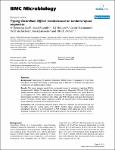Typing Clostridium difficile strains based on tandem repeat sequences
Zaiß, Henning
Rupnik, Maja
Kuijper, Ed J.
Harmanus, Celine
Michielsen, Dolf
Janssens, Koen
Nübel, Ulrich
Background: Genotyping of epidemic Clostridium difficile strains is necessary to track their emergence and spread. Portability of genotyping data is desirable to facilitate inter-laboratory comparisons and epidemiological studies. Results: This report presents results from a systematic screen for variation in repetitive DNA in the genome of C. difficile. We describe two tandem repeat loci, designated 'TR6' and 'TR10', which display extensive sequence variation that may be useful for sequence-based strain typing. Based on an investigation of 154 C. difficile isolates comprising 75 ribotypes, tandem repeat sequencing demonstrated excellent concordance with widely used PCR ribotyping and equal discriminatory power. Moreover, tandem repeat sequences enabled the reconstruction of the isolates' largely clonal population structure and evolutionary history. Conclusion: We conclude that sequence analysis of the two repetitive loci introduced here may be highly useful for routine typing of C. difficile. Tandem repeat sequence typing resolves phylogenetic diversity to a level equivalent to PCR ribotypes. DNA sequences may be stored in databases accessible over the internet, obviating the need for the exchange of reference strains.
No license information

